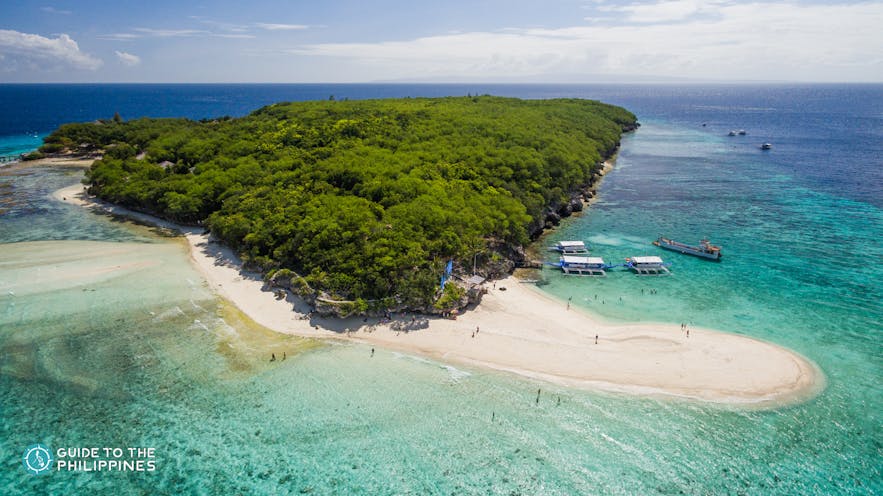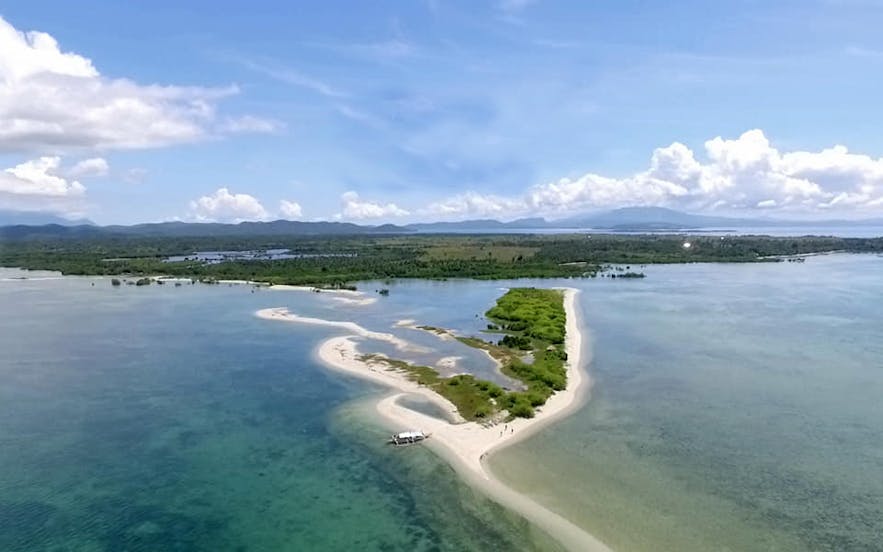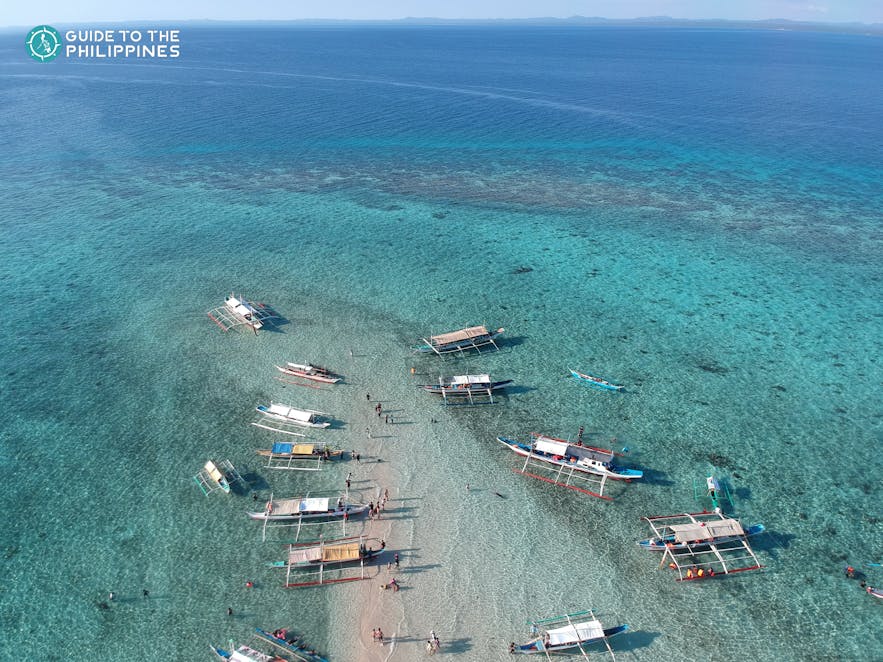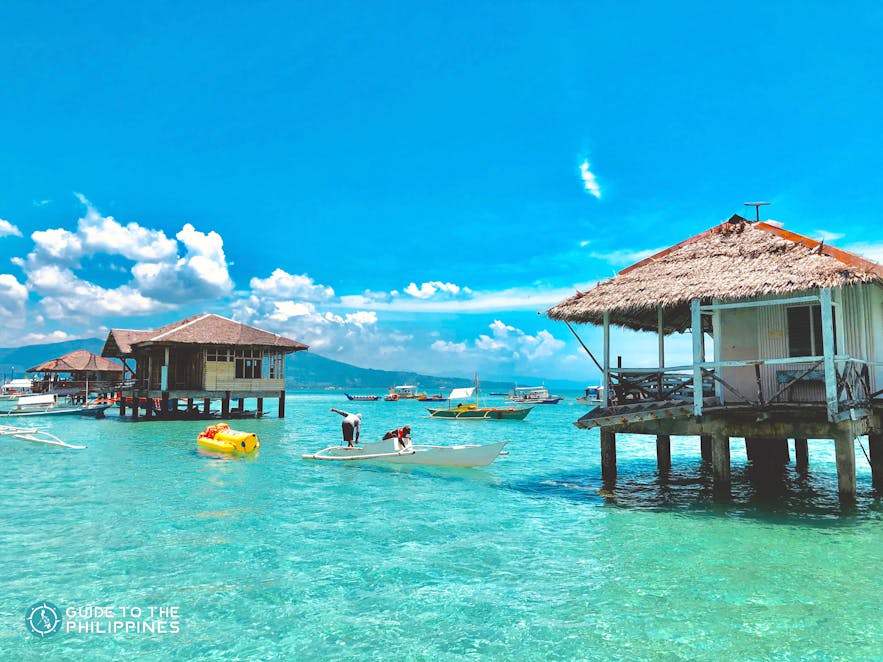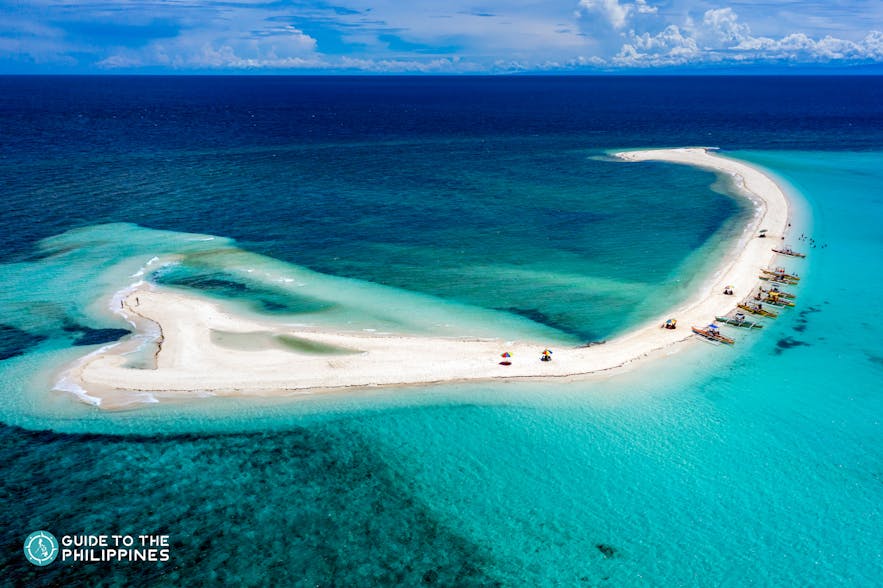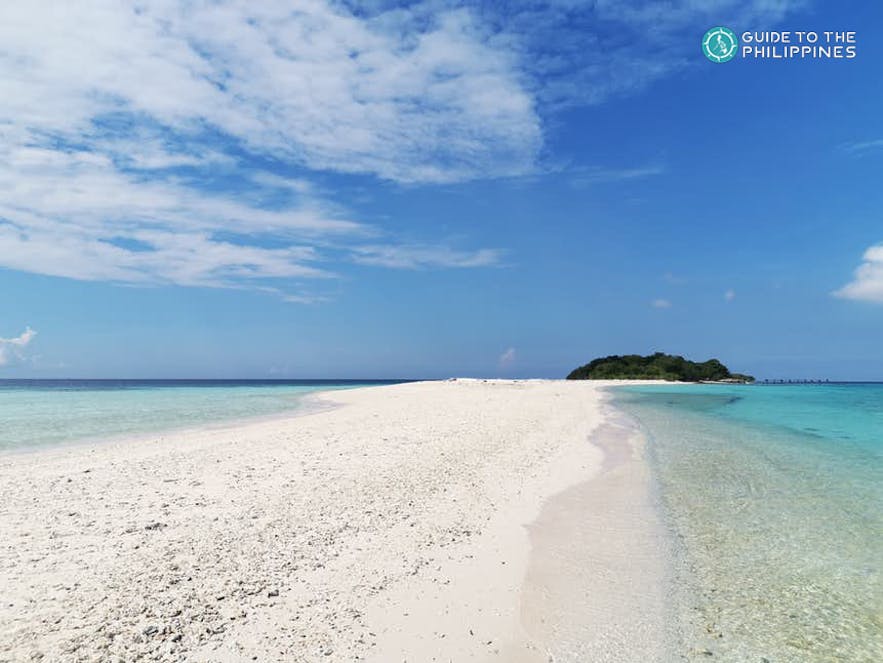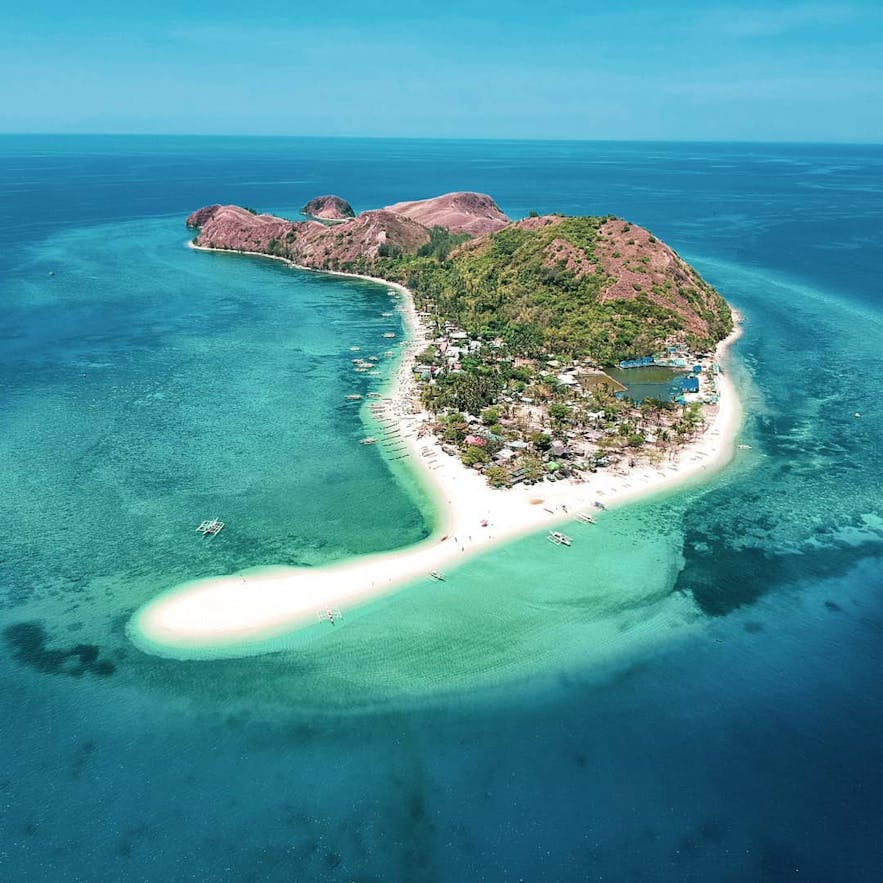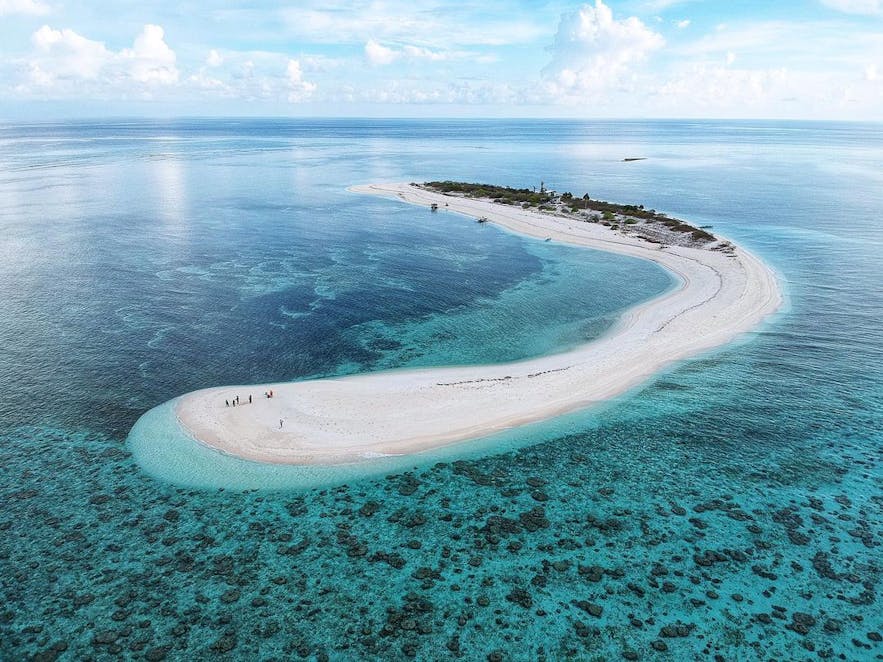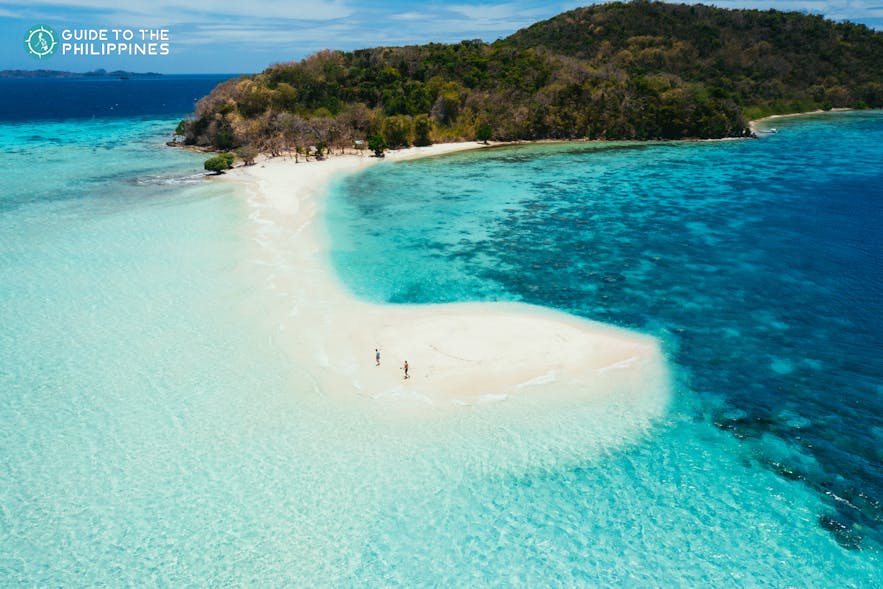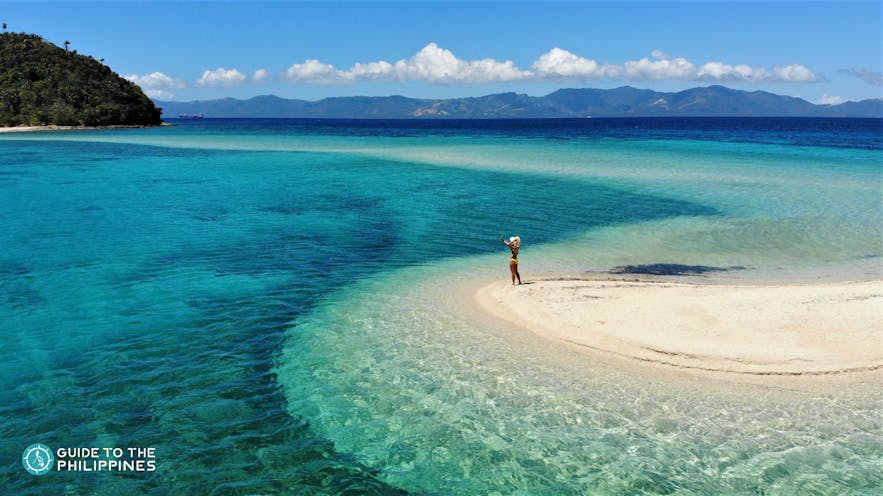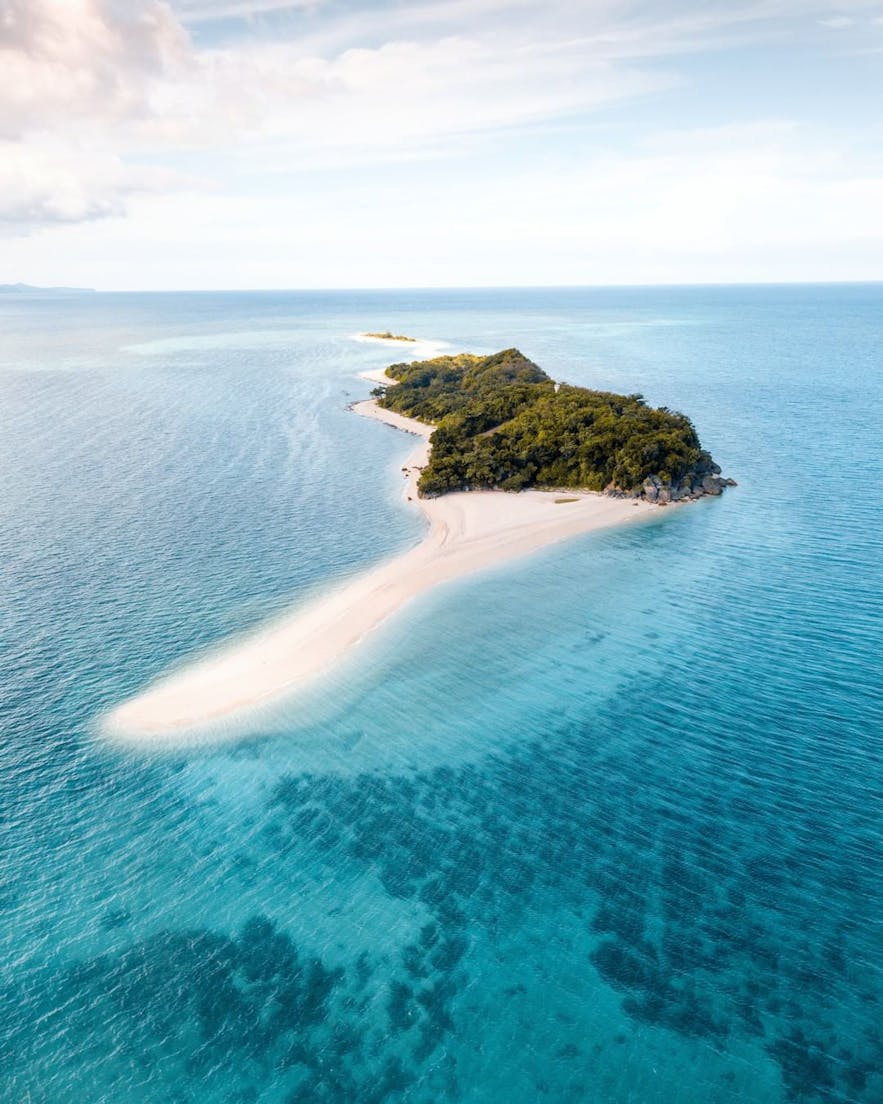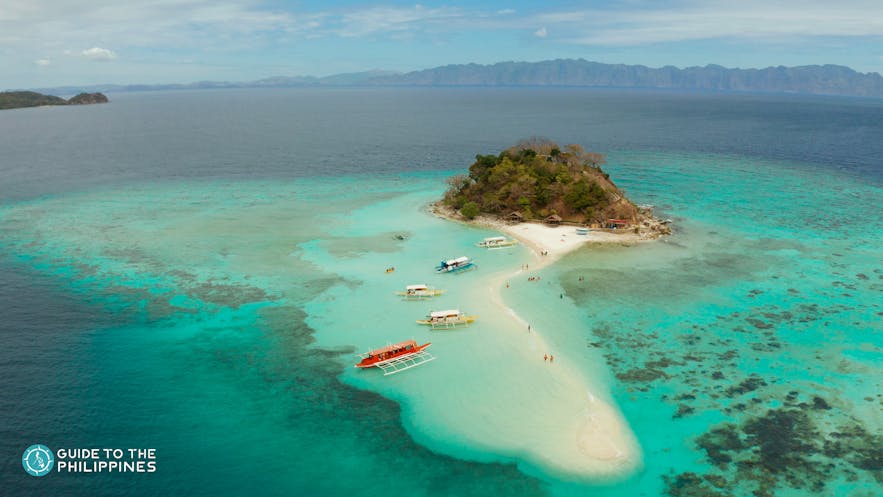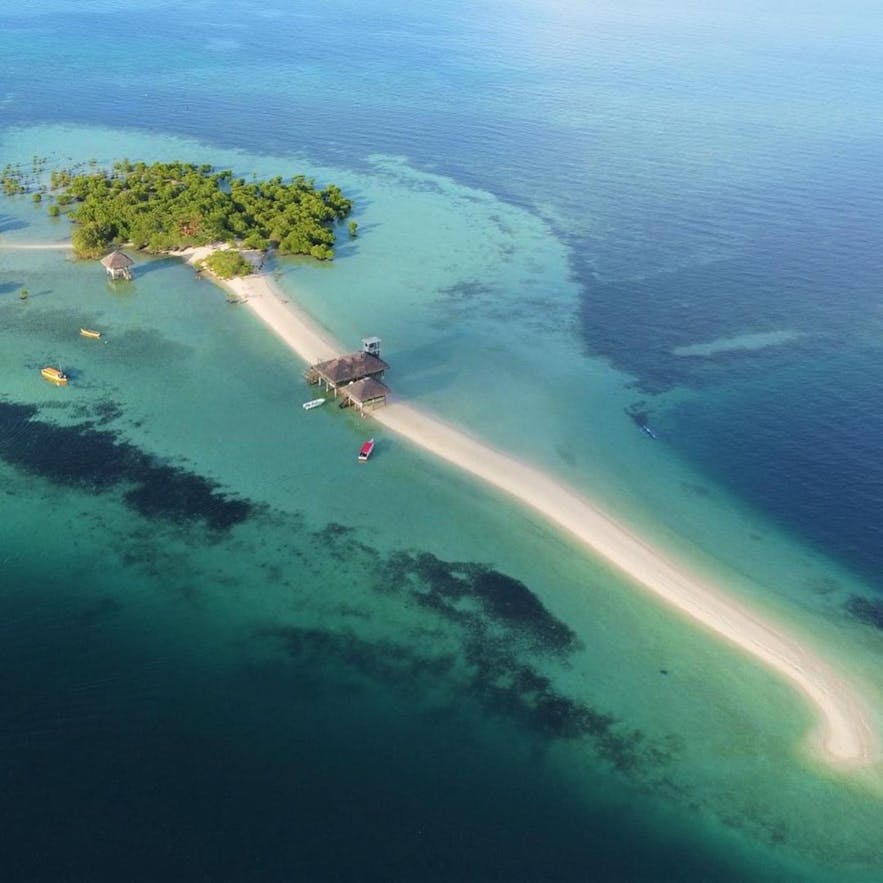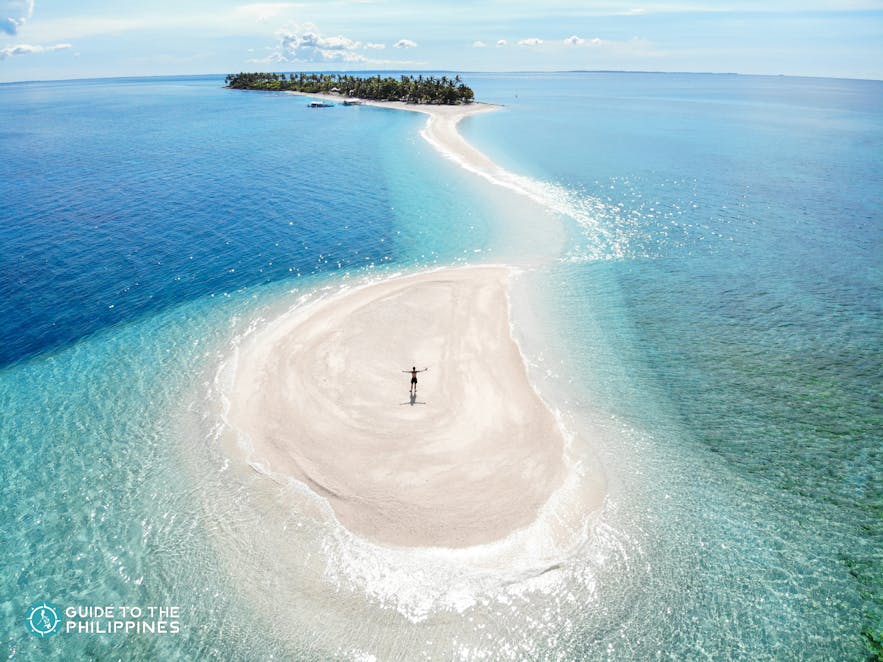Sand, Longest, Vanishing
The Philippines sits roughly 900 miles above the equator and is situated near the Pacific Rim, giving it year-long summer weather that is punctuated by monsoon rains and frequent typhoons. Its unique geography and location have resulted in an archipelago with many natural wonders, the most popular of which are its beaches, underwater coral reefs best explored when diving in the Philippines, and towering limestone caves.
Less known but equally breathtaking are its numerous sandbars. Just as there are more than 7,000 islands in the Philippines, so are there countless sandbars scattered throughout.
Each sandbar in the Philippines has its own special quirk and charm: some are long and snake-like, others are “naked” and devoid of natural ornamentation, while others still play hide and go-seek with travelers, disappearing when the water level is high only to re-emerge when the tide runs low. Even if you visit a lot of these sandbars, each one is bound to be a unique, unforgettable experience.
If you're not sure where to start, we've rounded down the 20 best sandbars in the Philippines that should be in your bucket list:
20. Puting Balas Sandbar (Zamboanga del Sur)
Puting Balas Sandbar is a relatively unknown natural attraction until fairly recently, where mostly local fishermen visit the place frequently in the course of performing their livelihood. Located off the coast of the provincial capital of Pagadian City, it is roughly 8KM away from the city center and sits comfortably in the middle of Pagadian Bay. To get there, you’ll need to ride a motorboat from the nearest port, which is about 5KM distance from the shore, the equivalent to a 30-minute boat ride,
It is a naked sandbar that juts at the center of Pagadian Bay almost unexpectedly. The white sand is fine and powder-like, and the surrounding water is pristine and crystal clear, with an endless 360-degree view of the seascape that can be enjoyed from every angle. Go there when the tides are high because this is one of those sandbars that “disappear” during the low tide.
19. Manlawi Sandbar (Camarines Sur)
Photo by @pdrm_films on Instagram
The Manlawi Sandbar is part of the Caramoan group of islets in Camarines Sur, the largest province in the Bicol region that is about 511KM away from Metro Manila by land, and may be reached via a one hour flight to the Virac airport. This sandbar is at the eastern side of the largest of the Caramoan Island group, namely Lahug Island.
What sets the Manlawi Sandbar apart is that at its peak, it forms a unique heart-shaped landmass that is only visible during the high tide, which typically occurs at midday when the sun’s rays are at its highest point.
When visible, the heart-shaped sandbar is about 1KM wide, with powder white sand that is soft to the touch and disappears completely during the high tide, with water about chest-deep in height. At various times of the day, the water grazes the ankles and is shallow enough to walk on.
18. Sumilon Island (Cebu)
Located off the southeast coast of Cebu near Oslob, Sumilon Island sits on the Cebu straight, an area teeming with colorful reefs and marine life. The sandbar is one of the best dive spots to explore. It has a marine sanctuary located nearby that’s perfect for scuba divers, while snorkeling is also a great way to discover the white sand and fish in the surrounding shallow waters.
Just like most sandbars, Sumilon Island is a shifting sea-based landmass that changes with the tides and the varying weather patterns. When the tides are higher, the southern tip morphs into a thinner sliver of sand stretching out into the ocean, while a bird’s eye view vantage point reveals a more visible coastal area. Sumilon Island is also part of a private resort called the Bluewater Sumilon, which offers great amenities for longer stays.
17. Panumbangan Sandbar (Sorsogon)
Photo by Sorsogon Provincial Tourism Office
Panumbangan Sandbar sits on a marine sanctuary where a flourishing marine ecosystem exists. Along with the colorful reefs and schools of fish, exotic seafood delicacies such as “lato” or green sea grapes and sea urchins or “uni” can also be harvested near the sandbar. Located in Pilar, Sorsogon, the Panumbangan Sandbar is about 500KM southeast of Metro Manila and may be reached through a motorboat ride from the Pilar Port.
The sandbar features a long strip of white sand jutting out of the blue sea, providing visitors with a panoramic view of not one, but two volcanoes, namely Mt. Mayon and Mt. Bulusan, both of which are situated in the Bicol region. Take a dip in the water and explore the fish in the ocean, and then have a hearty meal on the floating bamboo cottages in the surrounding areas, the perfect place to enjoy a delicious seafood meal after a long day of exploring the sandbar.
16. Palad Sandbar (Marinduque)
Palad Sandbar is located several meters off the coast of the north of Maniwaya Island, one of several islets in the municipality of Santa Cruz, Marinduque, a province in the southwestern Tagalog region bordering the Tayabas Bay. Early morning is the best time to visit Palad Sandbar because this is when most of the strip of sand is above water; arrive later and most of it would be submerged in shallow water. Visitors may still wade through the shores and enjoy the crystal clear sea surrounding it during high tide.
The high tide swallows up the Palad Sandbar by 11 AM, so plan ahead to make sure that you catch it above water while it is still at a low tide by riding a chartered motorized boat from Maniwaya Island in the early hours of the morning. Aside from missing the full strip of sandbar from appearing during the high tide, it is best to avoid the crowds that typically converge in the afternoon as well.
15. Manjuyod White Sandbar (Negros Oriental)
Located off the coast of Manjuyod in North Bais Bay, Negros Oriental, this famous sandbar is may be reached via a 15-minute motorized boat ride from the wharf in Bais. Manjuyod White Sandbar It is often compared to the Maldives because it has the same pristine blue waters and white sand as its famous Indian Ocean counterpart.
The low tide begins at the wee hours of the morning, so if you want to see the full length of the sandbar it is best to arrive earlier rather than later.
14. Corangon Shoal (Albay)
Corangon Shoal is a sandbar found in the municipality of Tiwi, Albay, a southeastern province about 470KM away from Metro Manila. Corangon Shaol is sometimes called Egg Yolk Island because its round shape resembles a sunny side up egg, with the drier white sand in the middle looking like the yolk. It is comprised of crushed corals and pearly white sand and may be reached via a 15-minute motorboat ride from the coast of Barangay Baybay.
It is a naked island surrounded by crystal clear turquoise-tinged waters all around it, offering a 360-degree view of its surrounding islets and spectacular seascape.
The half-hectare wide sandbar is the perfect vantage point from which to view three of Albay’s majestic land formations, namely Mt. Mayon, Mt. Marsaga, and Mt. Malinao. An unobstructed, panoramic view of these stratovolcanoes can be seen from the sandbar, a unique perspective from which to take memorable photographs and unforgettable memories.
13. White Island (Camiguin)
Situated a little over 1KM off the northern coast of Mambajao in Camiguin, White Island is a horseshoe-shaped sandbar is uninhabited and is devoid of any permanent structures, man-made and otherwise. One of the top tourist spots in Camiguin, there are no thatched roof huts or coconut trees swaying in the breeze here, just a lump of pure, unadulterated white sand gleaming under the sun’s rays standing right in the middle of the sea.
As with most sandbars, the U-shaped islet’s landscape changes as frequently as the shifting tides do, although much of it is still above water throughout the day. The best time to visit is in the early morning when the sun is not too hot on the skin. It is a great place to enjoy a panoramic view of two mountains, namely Mt. Hibok-Hibok and Mt. Vulcan, both of which you may visit by joining a Camiguin tour package. The water is perfect for taking a dip and for exploring some fish and seagrass along the shore.
12. Little Sta Cruz Island (Zamboanga City)
Little Sta Cruz Island is a strip of white sand located on the Basilan Strait, about 3.5KM south of Zamboanga City. It has a narrow portion leading into a denser area that has thick foliage and mangroves skimming the water’s edge. While the water is clear and inviting, swimming is strictly prohibited, and visitors are allowed to stay for only 10 minutes at a time. This is to limit the water from sunblock or lotion contamination as well as other chemicals that might potentially harm the fragile ecosystem.
A protected marine sanctuary for sea turtles and other endemic marine creatures, Little Santa Cruz is also known for its rare pink-tinged sand that strikes quite an image against the blue, turquoise sea surrounding it. There are local tour guides astride colorful paddleboats who could accompany visitors around the island for a small fee. Nearby is the Great Santa Cruz Island, where cottages, food stalls, and shower rooms are available as well.
11. Naked Island (Surigao del Norte)
Naked Island is a sandbar found within the fringes of the famous Philippine surf spot in Mindanao, Siargao Island, and is typically included in the day’s itinerary when you join island hopping tours in Siargao, with a jump-off point coming from the pier in General Luna.
The name Naked Island aptly describes this because there are no permanent structures built here, nor are there any inhabitants living on it. The teardrop-shaped sandbar is covered entirely with powder white sand and enveloped around clear blue waters, with a few starfish found near the shore.
Certain spots in Naked Island have stronger waves, while others have milder currents and are perfect for swimming in the ocean. Some parts of the sandbar disappear beneath the ocean during the high tide, so it is best to visit when most of the landmass is above sea level. Don’t forget to take lots of photographs and enjoy the unobstructed view of the seascape surrounding it.
10. Malalison Island (Antique)
Photo by @ironwulf on Instagram
This 54-hectare Malalison Island is an emerging beach destination in Barangay Culasi in Panay Island that is situated off the coast of Antique province. Unlike other sandbars, it has a small fishing community living on the island; some areas are covered with rolling hills and grassy knolls. Near the coastline, the seashore is covered in fine white sand and a clear blue sea.
The sandbar is found at the island's eastern tip, a thin sliver of milky white sand that snakes out into the ocean, forming a sand bridge that connects it to the main landmass. It disappears during the high tide and emerges only during the summer months when the southeast monsoon winds keep the tides low.
The sandbar, which stretches to about 100 meters from the beach, is the perfect spot to enjoy an unobstructed view of Mt. Madjaas and the Antique mainland. The clear water is perfect for swimming and snorkeling around the fringes where marine life is abundant.
9. Seco Island (Antique)
Photo by @marianetagaca on Instagram
This sandbar is located within the municipality of Tibiao, Antique, about 50KM west of Panay Island on the northeast section of the Sulu Sea. Seco Island is only 1.5KM long and is shaped like an elbow, its surroundings covered in turquoise blue water that is shallow enough for swimming. It is so remote that until recently, only fishermen were aware of its existence as it is oftentimes used as a temporary shelter when the waves are too strong to go back into the sea.
Aside from being an emerging natural attraction where tourists look for its picture-perfect surroundings, white sand, and unusual shape, it is a popular kiteboarding spot because of the strong winds around the island. With wind speeds that could propel kite-boarders up to 150 ft above the water, Seco Island possesses the perfect conditions for extreme water sport enthusiasts to perform daring tricks and aerial maneuvers.
8. Panampangan Island (Tawi-Tawi)
Photo by @bryehero on Instagram
The longest sandbar in the Philippines can be found in the municipality of Sapa-sapa, Tawi-Tawi, on Panampangan Island. Located along the Basibuli Shoal on the Celebes Sea, its sandbar extends to a little over 3KM into the ocean. From a bird's eye vantage point, it cuts a striking image of a fine white sand bridge reaching out gracefully into the blue-green turquoise waters that surround it. The mainland on which the sandbar extends from is punctuated by lush greenery, coconut trees, and the same powder-like white sand along its coastlines.
There are huts and cottages for guests wanting to spend the night here, which is good to know as it is also quite far from the mainland. Coming from the jump-off point in Tawi-Tawi, it typically takes 2 hours to reach by outrigger boat and less than an hour by speedboat, but it is well worth the trip as it's a rare chance to set foot on this spectacular natural attraction.
7. Ditaytayan Island (Palawan)
Ditaytayan Island is located at the center of the Calamian group of islands in Culion, Palawan, off the coast of Coron Bay. As one of the farthest to reach among the islets in the region, it is best to join any of the Palawan tour packages available to make the trip worthwhile, as other beach destinations are typically included in most island-hopping itineraries exploring the area.
Its triangle-shaped sand bar extends a few hundred meters into the turquoise blue ocean, with striking white sand that is surrounded by shallow waters and marine life beneath it. The water is cool and inviting, perfect for warding off the heat when the sun’s tropical rays become too intense, especially by mid-day when the sun is at its peak. The place is not as crowded compared to other popular tourist spots in the region, so you’re bound to get the perfect tropical island paradise picture while you’re there.
6. Bonbon Beach (Romblon)
Located in Romblon, a province in the Mimaropa Southwestern Luzon region, Bonbon Beach is just 3KM from the town proper of Poblacion. Compared to most sandbars, it is easier to reach because the beach it is connected to is adjacent to the town proper, so there’s no need to charter a boat from that jump-off point. The privately-owned beach has a majestic sandbar that disappears during the high tide and re-emerges otherwise. When it is visible, the white sand forms a bridge that connects the mainland to another islet off the coast, Bang-og Island.
Bang-og is a tiny, uninhabited island filled with thick greenery. It looks like a mound of grass from the sandbar and may be reached by foot when the sandbar is not submerged below sea level. The water can rise waist deep so it is best to plan your trip if you intend to visit the mysterious Bang-og when you visit this sandbar on Bon-bon beach.
5. Cresta de Gallo Island (Romblon)
Photo by @eric_traveljournal on Instagram
It’s easy to imagine being stranded in a remote tropical island when you set foot on Cresta de Gallo Island: located in the middle of the ocean in Romblon along the Sibuyan Sea. It takes anywhere between 45 minutes to almost 2 hours to reach by motorized boat from the mainland in the town of San Fernando.
It is best to go there when the water is calm; the strong waves could make the journey quite bumpy. There are no shops or hawkers around, and it is completely deserted save for a few other tourists you might bump into while you’re there.
This 4.5-hectare island features a long, winding sandbar that connects two larger parts of the island and another strip of fine, sugary white sand extending off the other end of the larger landmass. The denser areas are covered in trees, and the water surrounding it is pristine and clear, perfect for swimming and lounging by the shore.
4. Kalanggaman Island (Leyte)
This sandbar in Palompon, Leyte, was named Kalanggaman because it is shaped like a bird, which is what the root word ‘langgam’ means in the local dialect. When this mass of white sand shifts along with the changing tides and moving sea levels, it appears as if the two ends of the bird-shaped island’s wings are flapping mid-flight.
With its 795m sandbar that extends at both ends and aqua blue ocean water surrounding it, Kalanggam Island is a popular local attraction that draws many tourists to its shores.
There are accommodations like tents or huts available for tourists looking to stay overnight, while cottages may also be rented for day-trippers, but there are no permanent inhabitants on the island. The water is calm and perfect for swimming, and the tide is at its lowest in the morning when most of the sandbar emerges from the sea.
3. Bulog Dos Island (Palawan)
One of several islets that form the Calamianes group of islands in Palawan, Bulog Dos is a compact island with a ribbon-like sandbar that is linked to Malaroyroy Peninsula and the rest of Bulalacao. It appears above sea level in the morning and slowly settles lower into the sea bed as the day progresses, so it is best to visit earlier in the day to see it in its full glory.
Aside from the crystal clear waters and powder-like white sand, the island is known for its unusual rock formations near the shore. Venture further off into the shallow waters, and you’ll find marine life teeming with reefs, corals, and colorful fish, the perfect spot to go snorkeling.
- Read our article on the best hotels and resorts in Coron
If you go inward toward the center of the island, take a short trek up a small hill to get a majestic view of the seascape and the surrounding areas around Coron. There’s also a luxury resort at the adjacent island, which is walkable during low tide when the sandbar is visible.
2. Snake Island (Palawan)
Photo by Department of Tourism
This majestic strip of fine white sand of Snake Island connects the mainland beach into a tiny islet situated several meters from the shore. It is named after the snake-like shape that is clearly visible during the low tide, which cuts a striking image against a background of lush greenery, crystal clear waters, and stunning rock formations that surround it.
A stop to Snake Island is included in most itineraries of several El Nido island hopping tours offered within the vicinity along Bacuit Bay and is one of the best ways to explore the area.
- After walking across the sandbar, proceed onward until you’re at the bottom of a small hill that is surrounded by a lush mangrove. If you choose to walk toward the top, you’ll have a majestic view of the sandbar and the surrounding area. On your way back, go swimming around the calm blue sea where reefs, corals, and marine life can easily be seen in the shallow water.
1. Buntod Reef Marine Sanctuary and Sandbar (Masbate)
Photo by JM Nga VLOGS
This spectacular sandbar earns top points not only for the fine white sand and crystal clear water surrounding it but also for the ease and convenience of reaching it. Aside from being part of numerous Masbate island hopping tours, Buntod Reef Marine Sanctuary and Sandbar is roughly 1KM off the coast of Masbate island, just a 20-minute boat ride from the city center.
Another reason it's at the top of the list is that it is a well-maintained natural attraction. Covering almost 100 hectares of protected reef and mangrove forests, it has several low-impact facilities for tourists, such as cottages and huts for rent.
Walking on the sandbar during the low tide leads to the mangrove sanctuary, where the water is so clear and shallow you can see the bottom. There are warm and cool parts around the water, making it a great place to swim and cool off beneath the shade of the mangroves surrounding it.
Explore the Most Beautiful Sandbars of the Philippines
With its majestic sandbars that disappear with the tides only to re-emerge with the shifting waters, the Philippines is an archipelago filled with natural tropical attractions that cannot be replicated anywhere else. Along with these temperamental sandbars and spectacular beach destinations, the marine life in its surrounding area is a colorful underwater world teeming with corals, colorful fish, and beautiful reefs.
If you find yourself in a beach resort that has a sandbar nearby, don’t hesitate to book a boat ride to visit it. You’ll be rewarded with the unique experience of standing on a tiny tropical island while enjoying an unobstructed view of the beautiful seascape it encompasses. Read more articles about the islands and beaches of the Philippines to discover more about the beautiful tropical destinations in the country.



